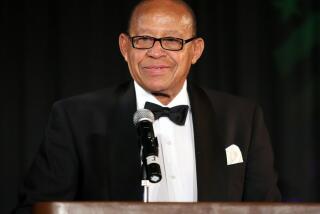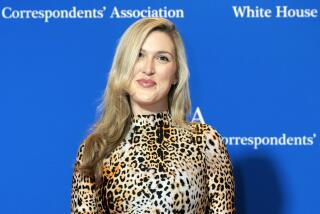Up From Anchorclone : HARD NEWS Women in Broadcast Journalism <i> by David Hosley and Gayle K. Yamada (Greenwood Press: $35; 196 pp.) </i>
Simone de Beauvoir and Lesley Stahl may seem unlikely people to link in one sentence, but that’s designed to catch your attention. As early as 1952, de Beauvoir spelled out in her book, “The Second Sex,” how women were identified as “the Other” and what that meant for both women and men. As recently as 1974, Stahl encountered the truth in de Beauvoir’s concept. She walked onto the CBS News set for an election-night discussion and found the participants all had their names on their chairs: “Cronkite,” “Mudd,” “Wallace.” Hers said: “Female.”
That doesn’t happen anymore but other indignities do. Television newswomen still are penalized for allegedly being “too old, too ugly, and not deferential to men.” They are not making breakthroughs to the top ranks that their numbers should warrant. Stories of the problems that women in broadcast news still face and the true grit they have displayed to get where they’ve gotten to today offer a rich lode for any author to mine. David H. Hosley and Gayle K. Yamada of San Francisco’s KQED have made a brave stab at it.
“Hard News” starts with radio days, days of women’s home companions Mary Margaret McBride and Ruth Crane, and goes on to chronicle women’s repeated attempts to move beyond kids and kitchens. As with women in the newspaper business, women in broadcasting news got their breaks in several waves: when men went off to World War II and later when the civil rights movement begat the women’s movement. Then news directors, like newspaper editors, realized that they had to change with the times like the businesses, political groups, and educational institutions they were covering.
This will be an important book for journalism students--now 60% female--to convey the history in the field many of them think will accord them stardom in five easy years. The raw material, the interviews with pioneers known and unknown, is all here. And believe me, having tried to find textbooks for a women-in-the-media course, this book is needed.
Why, then, do I have problems with this book? Having just written a parallel book about women in the newspaper business, I know the work that went into this effort. But, especially for the $35 I would have paid had I not been reviewing this book, I want color TV, not black and white. Here’s what I miss:
--Analysis of why the Federal Communications Commission was ready in 1971 to tell broadcasters that they had to extend equal opportunity guidelines to women when it had not been so inclined earlier.
--A sense of whether network downsizing has an unequal impact on women. Does the move to treat more and more news shows as entertainment shunt women back to fluffy features just when they were getting a toehold in straight news reporting?
--More than passing reference to NBC’s Cassie Mackin, a true pioneer.
--A deeper look at what’s special about National Public Radio, where we hear so many stellar women like Susan Stamberg, Linda Wertheimer, Cokie Roberts and Laurie Garrett.
--And most of all, while I value the capsule biographies where none existed between two covers before, I want to know whether these women made a difference. What news was covered that wouldn’t have been otherwise? Serving as role models is important, but broadening the definition of news to include more groups, more kinds of stories, may be women’s real contribution. That’s the case in newspapers; if it isn’t in broadcasting, what does that say about women’s influence?
We have this book. We have Christine Craft’s book about her lawsuit against Metromedia. And this summer we will have Marlene Sanders’ account of her long and distinguished career, plus a look at issues facing female broadcasters today. The pieces of the puzzle at least are being laid out on the table now for all to see even if they aren’t yet fully assembled.
More to Read
The complete guide to home viewing
Get Screen Gab for everything about the TV shows and streaming movies everyone’s talking about.
You may occasionally receive promotional content from the Los Angeles Times.






